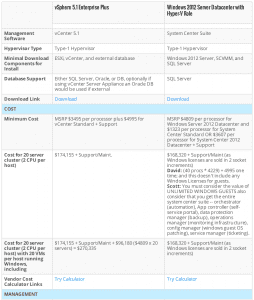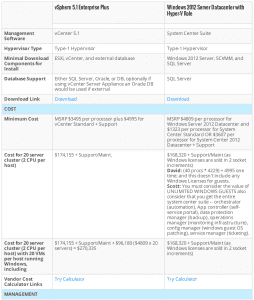
vSmackdown! vSphere 5.1 vs. Hyper-V 2012
Twenty years ago, the fight was Novell vs. Microsoft as Microsoft’s upstart Windows NT server operating system decimated Novell’s handsome share of the server market. Ten years ago, the war shifted to the desktop where debates raged over whether Apple or Microsoft made the superior desktop operating system.
Today, Microsoft is again doing battle in the data center and, this time, the future of that market is at stake as Microsoft and VMware take off the gloves in their individual quests for data center and, ultimately, cloud dominance.
In recent years, many vSphere vs. Hyper-V articles have been written and with relative ease since comparing Hyper-V’s enterprise credibility against vSphere was incredibly one-sided in favor of the latter. With the latest release of Hyper-V 2012, however, Microsoft has made great strides in the hypervisor war. In fact, according to some research, Hyper-V is quickly gaining ground against vSphere, particularly as a secondary hypervisor, although it certainly is a primary hypervisor for many customers.
In reality, today’s hypervisor battle is really about control of tomorrow’s cloud-controlled data centers. The company that wins the data center battle will be perfectly leveraged to ease customers into hybrid computing models and, from there, all sorts of public cloud computing scenarios.
Scott & David: Our Take on your Options
Time to Go Head-to-Head!
The charts you see below focus on the single hypervisor front in the cloud war, but this front is, perhaps, one of the most critical…
Note: Our premium hypervisor comparison chart is available for use on your site or blog via the embed code at the end of the chart – Share away!
[one_half]
Premium Hypervisor Comparison
Both VMware and Microsoft sell to customers a software package that includes the individual hypervisor product as well as a suite of management tools intended to manage those hypervisor layers. The table below compares the paid editions of vSphere and Hyper-V:
 [/one_half]
[/one_half]
[one_half_last]
Free Hypervisor Comparison
While the paid product versions are generally preferred due to the significant feature sets included in the bundled products, both VMware and Microsoft provide to the market completely free editions of their hypervisor products. While these free editions do not carry some of the benefits of the paid editions, they are still feature-filled products or which there may be innumerable use cases. The chart below compares the free editions of the products from both VMware and Microsoft:
 [/one_half_last]
[/one_half_last]
Further Reading & Resources
Scott recently wrote a whitepaper (commissioned by Solarwinds) comparing hypervisors from a management and monitoring overhead perspective. Free copies of this must-read whitepaper are available for download here.
Additionally, if you’re curious how Citrix and Red Hat factor in, be sure and check out Andreas’ excellent comparison tool available on his VirtualizationMatrix.com site.
Your Turn…
What Say You? What factors made you go with one solution vs. the other? Share your thought process in the comments!